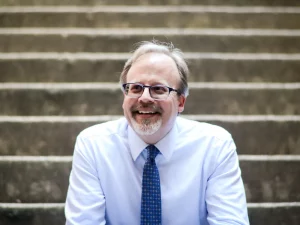
Photo: Ajijchan | Dreamstime.com
Chattanooga: The gig city is going quantum
05 April 2023
by Sarah Wray
EPB, Chattanooga’s city-owned energy and telecom utility, made a name for itself over a decade ago with the launch of a gigabit-speed, community-wide fibre optic network. Now it has designs on another ‘first’ with an industry-led, commercially available quantum network, working with Qubitekk.

The ‘quantum-as-a-service’ offering will allow private companies, government and university researchers to run quantum equipment and applications in an established fibre optic environment.
Cities Today spoke to J. Ed. Marston, EPB’s Vice President of Strategic Communications, to find out more about the initiative.
CT: What spurred you to pursue a quantum network?
JEM: The foundation for EPB Quantum Network builds on an effort that began more than five years ago.
With US Department of Energy funding aimed at securing America’s electric grid against cyber threats, EPB, Qubitekk, Oak Ridge National Laboratory and Los Alamos National Laboratory partnered in 2021 to run quantum encryption technologies across real-world fibre optic loops that EPB established between some of its electric substations.
This work won an R&D 100 Award in 2021, and the expertise and partnerships EPB built through this project were the foundation for launching EPB Quantum Network.
CT: Why are quantum networks different?
JEM: Quantum-based communications reproduce a naturally occurring phenomenon in which light particles (photons) can be linked or ‘entangled’ such that any change in one of the photons is instantaneously mirrored by its ‘twin’ even when they are separated by great distances.
In contrast to conventional computing and networking, which rely on sequential processing, entangled photons called qubits can be used to process multiple parallel paths of data at the same time. Each qubit also has the potential for carrying multiple pieces of non-binary data (unlike conventional data units which are binary ‘on’ or ‘off’ information).
CT: Why should residents and businesses be excited about this?
JEM: EPB launched its community-wide fibre optic network in 2009. In the first ten years of its operation, it generated nearly US$2.7 billion in economic benefits, including more than 9,500 jobs.
Being positioned on the leading edge of quantum industry innovation holds the promise of even more education, job creation and other benefits that can draw investment and improve quality of life in the Chattanooga area.
CT: Your announcement said quantum holds “promise to revolutionise computing, cybersecurity, healthcare and finance” – can you expand on this with any examples?
JEM: Quantum technology holds great potential for processing and transmitting much more information at speeds that are almost unfathomable when compared to today’s technology – many times faster than the fastest supercomputer. Although quantum technologies are still very much in the development stage, they hold the potential for future applications that might include:
- Healthcare: Modelling new vaccines and medical treatments in a fraction of the time.
- Finance: Using artificial intelligence and advanced predictive modelling to enhance your company’s competitiveness.
- Education: Creating more interactive educational opportunities through photo-realistic virtual reality.
- Safety: Next generation weather modelling that would allow us to issue much more accurate warnings before tornadoes, earthquakes, tsunamis and other natural disasters happen.
- Communications: Simultaneously and instantaneously translating multiple languages.
CT: There is also a focus on helping residents prepare for opportunities in the emerging quantum technology sector. Can you tell us more about this?
JEM: Educational resources at GigCityGoesQuantum.com will be designed for students (fifth grade through university) and anyone with a curious mind. While today’s students will likely be the ones who see today’s quantum developments become part of our everyday lives, our higher education institutions (University of Tennessee at Chattanooga and Chattanooga State Community College) are developing programmes to address the needs of those already in the workforce who will work in quantum industries.
The kind of activities that will be posted at GigCityGoesQuantum.com when it goes live will include five separate livestreamed Quantum Education Events presented by quantum scientists for high schoolers, university students and interested adults. There will be on-demand videos about quantum technology. Games and interactive online activities for children as young as kindergarten will also be available.
These free activities were developed or presented by national and local educators, physicists, workforce development professionals and entrepreneurs, thanks to support from Hamilton County Schools, Chattanooga State Community College, the University of Tennessee at Chattanooga, Chattanooga 2.0, Public Education Foundation Chattanooga, National Science Foundation, National Q-12 Education Partnership and Xairos.
CT: What is the expected cost and investment for the quantum network?
JEM: EPB Quantum Network was funded from an existing, EPB board-approved budgetary line item dedicated to innovative infrastructure development at a cost of about US$4.5 million over two years.
CT: What is the expected timeline?
JEM: By summer 2023, companies that subscribe to EPB Quantum network will be able to run and validate their own equipment on the fibre optic network in support of their efforts to commercialise the technologies they are developing.
This will allow private companies, government agencies and academic researchers to use the quantum-as-a-service offering.
CT: What are the challenges of deploying a quantum network like this?
JEM: EPB Quantum Network powered by Qubitekk is America’s first industry-led, commercially available quantum network designed for running equipment and applications in an established fibre optic environment.
We have designed it to be configurable so that it can be adjusted to the needs of different quantum technology companies as they work to commercialise different kinds of quantum software and equipment.
At the same time, EPB Quantum Network is designed to provide an environment where different companies can collaborate and demonstrate the interoperability of the technologies they are developing with hardware and software developed by other companies.
Because quantum technologies are so cutting edge, there are many technical challenges that must be overcome, but we are already sharing quantum states across EPB Quantum Network, and we stand ready to collaborate with quantum technology developers and make adjustments to support the emergence of quantum technology as a newly emerging economic sector.
CT: Is there anything you’d like to add – particularly that might be of interest to other cities?
Although we are beginning with Chattanooga’s community leaders, universities, schools and companies, we want to work cooperatively across the US to spread the momentum started here.








